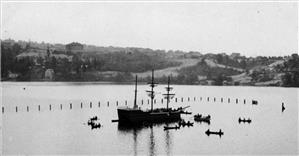On September 17, 1909, the Boston Tea Party, complete with a dramatic shelling of a replica of the ship
Gaspee,
is reenacted on Lake Union as part of a special event for the Alaska-Yukon-Pacific Exposition. The exposition took place between June 1 and October 16, 1909, drawing more than three million people. Visitors came from around the state, the nation, and the world to view hundreds of educational exhibits, stroll the lushly manicured grounds, and be entertained on the Pay Streak midway, while Seattle promoted itself as a gateway to the rich resources of Alaska, the Yukon, and Asia. Although the A-Y-P event does not entirely track the actual facts of the Boston Tea Party or the burning of the
Gaspee
(which were actually two separate episodes that occurred 18 months apart), it makes no difference. The ship explodes with an awe-inspiring roar; the crowd whoops in delight, and two bands play patriotic music to add to the glory of the scene.
History with a Flare
Friday, September 17, 1909, was -- relatively speaking -- one of the quieter days at the Alaska-Yukon-Pacific Exposition. So it was with considerable glee and anticipation that some 6,000 A-Y-P visitors gathered at the foot of the Pay Streak midway near the shore of Lake Union at 9 p.m. to watch the event of the day: a reenactment of the Boston Tea Party and burning of the British ship Gaspee, all on Seattle’s own Lake Union.
Promptly at 9 p.m. under cool, starry skies, a party of 12 men, disguised as Indians, silently put off from the Lake Union shore in small skiffs. At anchor a short distance away in the lake floated a replica of the ship Gaspee. This ship had admirably served as the Mayflower in the fair’s New England Day celebrations the prior Saturday, and afterward had been remodeled to represent the British schooner Gaspee, which was burned by American colonists off the shore of Rhode Island in 1772.
Tea and Fire
Presently the crowd on shore saw a red fire on the ship, with the “Indians” silhouetted against the fire tossing 20 chests of “tea” into Lake Union. After throwing the chests into the lake, the raiders abandoned ship and paddled back to land. Batteries stationed on the shore then opened up on the craft, which turned out to be built a little sturdier than the planners had anticipated: It took 30 six-inch shells to set the boat ablaze. It finally caught fire on its left side, and flames, “rapidly gaining headway, were soon belching from every port of the vessel” (Seattle P-I). The fire soon climbed the ship’s rigging, the masts theatrically fell, the boat quickly burned to the water line, and then the fire reached the ship’s magazine, where “ammunition” -- two strategically placed cases of powder -- was stored.
The ship exploded with a thunderous roar that could be heard all along the lake, rocketing fragments of burning boat high into the air in a brilliant pyrotechnical display. The crowd erupted with a mighty huzzah, their fervor fueled by appropriately patriotic music from Wagner’s A-Y-P band and the Clan Fraser Highland pipers, who wouldn’t have missed this event for the world.
No one seems to have mentioned -- and probably most were not aware -- that the re-enactment was not entirely historically accurate. The Gaspee had nothing to do with the Boston Tea Party; it was destroyed 18 months prior to the event, and it wasn’t shelled; the Americans simply torched it (though the ship did explode quite spectacularly once the fire reached its powder magazine). In addition, no ships were burned during the actual Boston Tea Party in December 1773. But no matter. The crowd was more than willing to be a little loose with the historical facts in exchange for a little dramatic license, and, proudly concluded the Post-Intelligencer the next day, “The spectacle was declared to have been one of the best presented since the opening of the exposition.”

